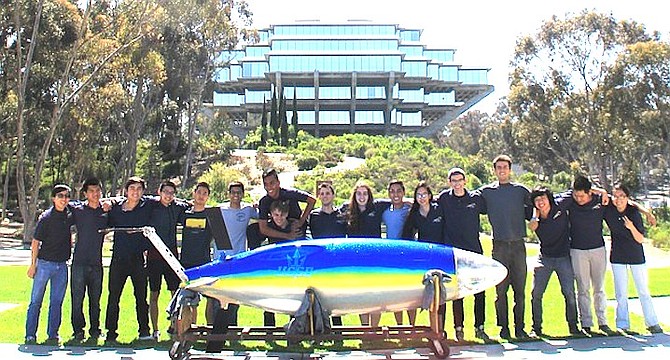 Facebook
Facebook
 X
X
 Instagram
Instagram
 TikTok
TikTok
 Youtube
Youtube

For the first time in UC San Diego history, the school’s human-powered submarine team has been invited to participate in the European International Sub Race. In July 2018, the team of engineering undergrads will fly across the pond with their submersible, named Vaquita for its dolphin-inspired propulsion fin. The vaquita is a critically endangered species of dolphin native to Baja California waters.

In years past, UC San Diego’s human-powered subs have only competed stateside. The biennial European international races host 12 university teams at the Ocean Basin Testing pool in Gosport, England. The pool—as long as a football field—belongs to QinetiQ, a British multinational defense technology company. It’s where they test scale models of aircraft carriers for the Royal Navy.
Different from stateside competition, the international race requires the subs to negotiate tight turns in an underwater slalom. With this added challenge, the engineering students chose to make a major innovation to this year’s sub: electronic steering. The team tested Vaquita’s seaworthiness—including function of the dead man buoy—in Canyonview Pool on campus. They plan to submerge it in salt water at La Jolla Shores before leaving for England.
“They used corrosion resistant materials,” insisted two students from last year’s team.
Powered by a pilot pedaling frantically, looking through a transparent nose cone and sucking on a SCUBA tank, the submarine generates motion with a drivetrain that moves the dolphin tail. Initially a joystick controlled the electronic steering system, but later the team added sensors for convenience. The steering moves fins on the top, bottom, and sides.
Vaquita boasts a paint job by UC San Diego artist Rubén Ortiz-Torres. The fins were 3D printed from polylactic acid plastic. Local company OceanAero donated carbon fiber for the vessel’s body, along with a lesson for the young students on the process of vacuum assisted resin infusion.
Though the hull of the submersible isn’t watertight, and the design doesn’t contribute anything new to waterproofing research—that’s not the point of this engineering exercise. The idea is to test the problem-solving abilities of the young engineers.
Grand total for the project was $11,600. The team was invited to the races on June 2nd, so they are currently raising funds to ship the sub to England. Check out a video of the build process at https://www.gofundme.com/ucsdhps


For the first time in UC San Diego history, the school’s human-powered submarine team has been invited to participate in the European International Sub Race. In July 2018, the team of engineering undergrads will fly across the pond with their submersible, named Vaquita for its dolphin-inspired propulsion fin. The vaquita is a critically endangered species of dolphin native to Baja California waters.

In years past, UC San Diego’s human-powered subs have only competed stateside. The biennial European international races host 12 university teams at the Ocean Basin Testing pool in Gosport, England. The pool—as long as a football field—belongs to QinetiQ, a British multinational defense technology company. It’s where they test scale models of aircraft carriers for the Royal Navy.
Different from stateside competition, the international race requires the subs to negotiate tight turns in an underwater slalom. With this added challenge, the engineering students chose to make a major innovation to this year’s sub: electronic steering. The team tested Vaquita’s seaworthiness—including function of the dead man buoy—in Canyonview Pool on campus. They plan to submerge it in salt water at La Jolla Shores before leaving for England.
“They used corrosion resistant materials,” insisted two students from last year’s team.
Powered by a pilot pedaling frantically, looking through a transparent nose cone and sucking on a SCUBA tank, the submarine generates motion with a drivetrain that moves the dolphin tail. Initially a joystick controlled the electronic steering system, but later the team added sensors for convenience. The steering moves fins on the top, bottom, and sides.
Vaquita boasts a paint job by UC San Diego artist Rubén Ortiz-Torres. The fins were 3D printed from polylactic acid plastic. Local company OceanAero donated carbon fiber for the vessel’s body, along with a lesson for the young students on the process of vacuum assisted resin infusion.
Though the hull of the submersible isn’t watertight, and the design doesn’t contribute anything new to waterproofing research—that’s not the point of this engineering exercise. The idea is to test the problem-solving abilities of the young engineers.
Grand total for the project was $11,600. The team was invited to the races on June 2nd, so they are currently raising funds to ship the sub to England. Check out a video of the build process at https://www.gofundme.com/ucsdhps
Comments